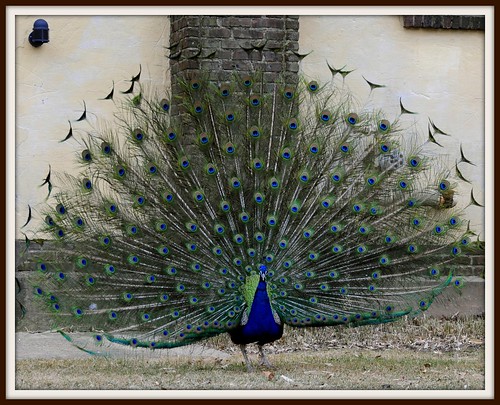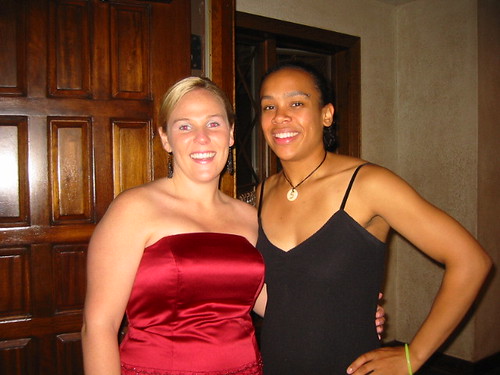
Check out these sex only images:
Peacock Plumage (3 of 4)

Image by Tony the Misfit
The male peafowl, or peacock, has long been known for and valued for its brilliant tail feathers. The bright spots on it are known as "eyes", and inspired the Greek myth that Hera placed the hundred eyes of her slain giant Argus on the tail of her favorite bird.
Close-up of a male Indian Peafowl's plumage
Indian Peafowl has iridescent blue-green or green coloured plumage. The so-called "tail" of the peacock, also termed the "train," is not the tail quill feathers but highly elongated upper tail feather coverts. The train feathers have a series of eyes that are best seen when the train is fanned. The actual tail feathers are short and gray-colored and can be seen from behind when a peacock's train is fanned in a courtship display. During the molting season, the males shed their stunning train feathers and reveal the unassuming gray-colored tail which is normally hidden from view beneath the train. Both species have a crest atop the head.
The female (peahen) Indian Peafowl has a mixture of dull green, brown, and grey in her plumage. She lacks the long upper tail feather coverts of the male but has a crest. The female can also display her plumage to ward off female competition or danger to her young.
The Green Peafowl is very different in appearance to the Indian Peafowl. The male has green and gold plumage and has an erect crest. The wings are black with a sheen of blue.
Unlike the Indian Peafowl, the Green Peahen is very similar to the male, only having shorter upper tail feather coverts and slightly less iridescent in some regions. Like other peafowl, it is very difficult to distinguish a juvenile male from an adult female. Moreover, the sexes of the various Green Peafowl species are almost impossible to tell apart in the field during the months when the male has no train.
Many of the brilliant colours of the peacock plumage are due to an optical interference phenomenon (Bragg reflection) based on (nearly) periodic nanostructures found in the barbules (fiber-like components) of the feathers.
Different colours correspond to different length scales of the periodic structures. For brown feathers, a mixture of red and blue is required: one colour is created by the periodic structure, and the other is a created by a Fabry-Perot interference peak from reflections off the outermost and innermost boundaries of the periodic structure.[citation needed]
Such interference-based structural colour is especially important in producing the peacock's iridescent hues (which shimmer and change with viewing angle), since interference effects depend upon the angle of light, unlike chemical pigments.
The plumage of the peacock, and the peahen's preference for its exorbitance, is a classical example of sexual selection and especially the handicap principle. However, in recent years scientific research has shown that the size and brilliance of a male's plumage does not meaningfully correlate with his mating success nor his health, and that instead the key factor for attracting females is the vocalizations made prior to mating.
source: wiki
184_7422 are you photographing me

Image by Kate's Photo Diary
The Rainbow Lorikeet is unmistakable with its bright red beak and colourful plumage. Both sexes look alike, with a blue (mauve) head and belly, green wings, tail and back, and an orange/yellow breast. They are often seen in loud and fast-moving flocks, or in communal roosts at dusk.
The Rainbow Lorikeet occurs in coastal regions across northern and eastern Australia, with a local population in Perth (Western Australia), initiated from aviary releases.
The Rainbow Lorikeet mostly forages on the flowers of shrubs or trees to harvest nectar and pollen, but also eats fruits, seeds and some insects.
The eggs of the Rainbow Lorikeet are laid on chewed, decayed wood, usually in a hollow limb of a eucalypt tree. Both sexes prepare the nest cavity and feed the young, but only the female incubates the eggs.
The Rainbow Lorikeet has acclimatised well to urbanisation and is commonly encountered in well-treed suburbs.
www.birdsinbackyards.net/finder/display.cfm?id=97
Meghan & Me

Image by swirlspice
There's a story about a ski trip we all went on a long time ago and Meghan (Maureen's little sister) came with us. The word "cleaning" became a euphemism for sex and even though this is only the second or third time most of us have ever hung out with Meghan, she will forever be associated with "cleaning."

Similar posts to:
small:
I Just Facebooked Your Mom Women’s T-shirt, Funny Womens Shirts (Many Colors Available), Small, Black ...
Small Acts of Sex and Electricity ...
Cool Small Sex images ...
I’m about to have sex with a girl and I’m afraid that I am too small? ...
Red Hot Chili Peppers T-Shirt – Blood Sugar Sex Magik – Small ...
Nice:
Nice Sex Scandal photos ...
Nice Red Sex photos ...
Nice Sex On Mobile photos ...
Nice Life Sex photos ...
Nice Human Sex photos ...
photos:
Nice Sex Scandal photos ...
Nice Red Sex photos ...
PHOTOS: Paris Hilton ‘Red-y’ To Turn 30, Cy Gives Her A Yellow Lexus! ...
Nice Sex On Mobile photos ...
Nice Life Sex photos ...
Peacock:
Plumage:
No comments:
Post a Comment
Note: Only a member of this blog may post a comment.